Prague Coat of Arms
There’s always history in a coat of arms and it’s often changed through the years but normally it’s a family coat of arms. In this case I’ll walk you through the origins of the Prague Coat of Arms, how things have changed over the years and why we’ve settled on the current version.
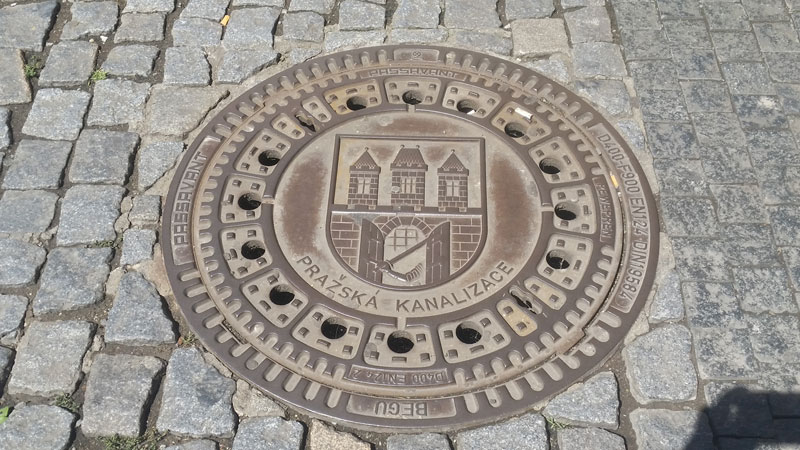
The Beginnings of the Prague Coat of Arms
In late 12th Century Prague the ruling family of the day called the Premyslid Dynasty started minting silver coins and to identify it’s origin they were stamped with a double-tailed Bohemian lion standing on it’s hind legs. This would be included in any coat of arms connected with Bohemia from then on.
By the middle of the 15th Century, Prague is not actually Prague as you know it today. It’s basically a Castle on one side of the river, the Lesser Town Market and a couple of towns on the other side. The larger by population is the Old Town and by the 15th Century they had fortified their town with a wall with fortified gates (from the Charles Bridge and what are now known as Wenceslas Square and Republic Square). One day somebody thought “wouldn’t it be nice to have an Old Town coat of arms”. So they designed the three towers over the portcullis gate although the colour was silver on red. It’s important to understand that some coats of arms just show a picture of towers in the shape of a shield which is called the “lesser” coat of arms. When you see the towers with the blocks defined then each block represents a “Cadestre”. Loosely you could call this a parish in old times, now it would be a sub-district. For example, Prague 8 is a district but within it are Liben, Karlín, Bohnice, Troja, Kobylisy, Cimice, Dáblice and Dolní Chabry which are cadestres. There are more than 120 cadestres in modern Prague.
Let’s skip to 1462
The Austrian empire ruled from Vienna. Prague was ruled by King George of Podebrady. When Vienna was attacked during a civil war, King George raised an army from the Old Town and sent it to help defend Vienna. This was successful and the Emperor wanted to thank Prague for it’s help plus he asks for their “silver on red” coat of arms to be added to the victory colours. Now, I’ll be honest here and say I don’t know for sure what happened next. It was either lost in translation or the Emperor wanted it but the towers on the lesser coat of arms were changed to gold. But that’s just a small part of the overall design. The larger version is where the changes will be seen.
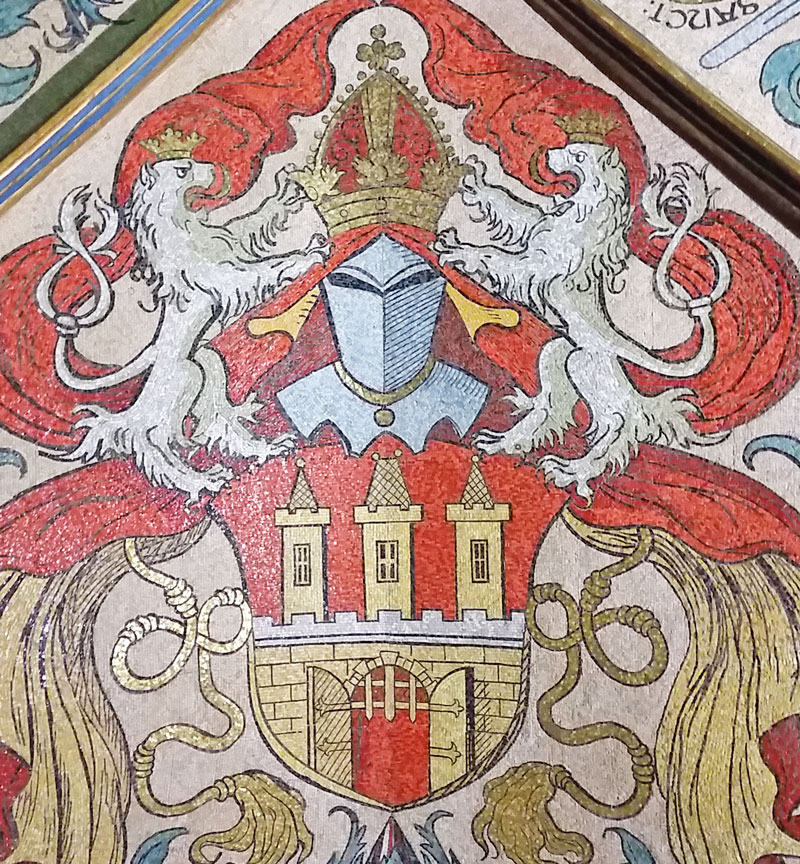

So in the 1460s there was still no overall Prague coat of arms but the Old Town Coat of Arms now looked like the picture above. Basically the “Lesser” coat of arms (the bit within the shield shape) is the one bestowed by the Emperor. Included in the decoration are two Bohemian lions (they look white but they are silver) either side of a knights helmet (the king) with the crown on top. You can see this above the decorative window on the terracotta coloured building of the Old Town Hall.
1648
The Thirty Years War is ending and people are celebrating. Emperor Ferdinand III alters the coat of arms so that the “Lesser” version has an arm with a sword in front of the portcullis gate and the most common place to see this image is on drain covers (pictured at the top of the page).
This is either an overall victory image or more likely directly related to the siege of the Old Town the year by Swedish forces. The Old Town did not fall. He also changes the overall design by replacing the Czech crown with the Habsburg crown over a central helmet plus two more helmets, the Habsburg double black eagle motif and heraldic flags.
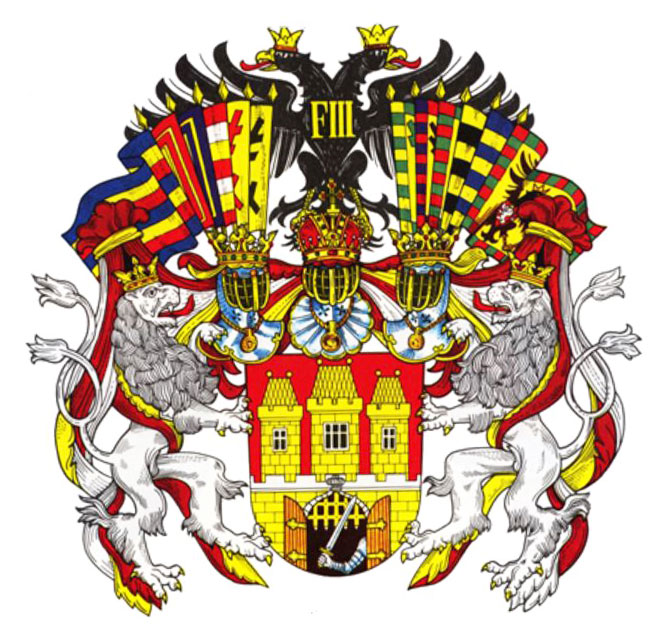
There was no motto and the only visible characters are FIII (Ferdinand III) so above is what the Old Town Coat of Arms looked like in 1650.
1784
In 1784 King Joseph II unifies the 4 historic areas of the Castle, Lesser Town, Old Town and New Town into what would be called Prague 1 today. This new collective “Prague” adopts the Old Town Coat of Arms.
1918
At this time the Austro-Hungarian Empire is about to implode. Czechoslovakia has been formed and hence, new heraldry is required including a new Prague coat of arms.

They keep the “arm and sword” as this was not considered an imperial feature but more a town celebration.
The Habsburg crown is replaced by a simple Czech crown (remember this is a republic now)
The Heraldic family flags are replaced by two sets of 12 historic Czech city flags.
The double headed black eagle is replaced by another crowned Bohemian lion facing to the left with the Slovakian emblem at it’s heart (remember that Prague would be the capital of this new country which included ethnic Slovakians).
The motto “Prague Mother of Cities” is added.
The Czech National Tree “Lipa” (Linden Tree) is added.
1960
After the 1948 Communist Coup the coats of arms are the same until in 1960 when Czechoslovakia remains as a country but is divided into two federal states. It is renamed as the Czechoslovak Socialist Republic or CSSR and three changes are visible.
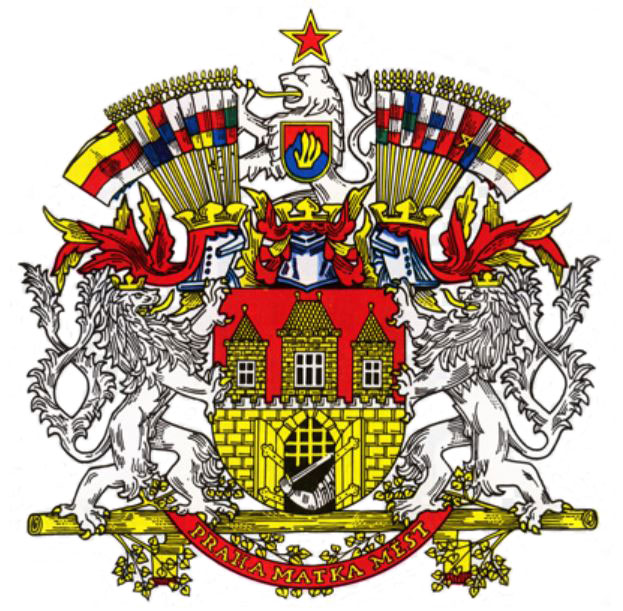
Firstly the centre Bohemian Lion has it’s crown removed and replaced with the Soviet 5 pointed red star.
Secondly the Slovakian emblem (double bar christian cross) at the heart of the lion was replaced by the Slovak WW2 partisan symbol (looks like yellow flames on a red and blue background).
Third is that the flags are now those from the 22 official Prague districts.
They kept the same motto.
1993 – Nearly There
The communists fell in 1990 and the coat of arms went back to the 1918 version. The country splits on January 1st 1993 in the Velvet Divorce and for the first time we have a sovereign state called the Czech Republic and you know what that means, yes another Prague Coat of Arms. This time it’s pretty simple with two changes.
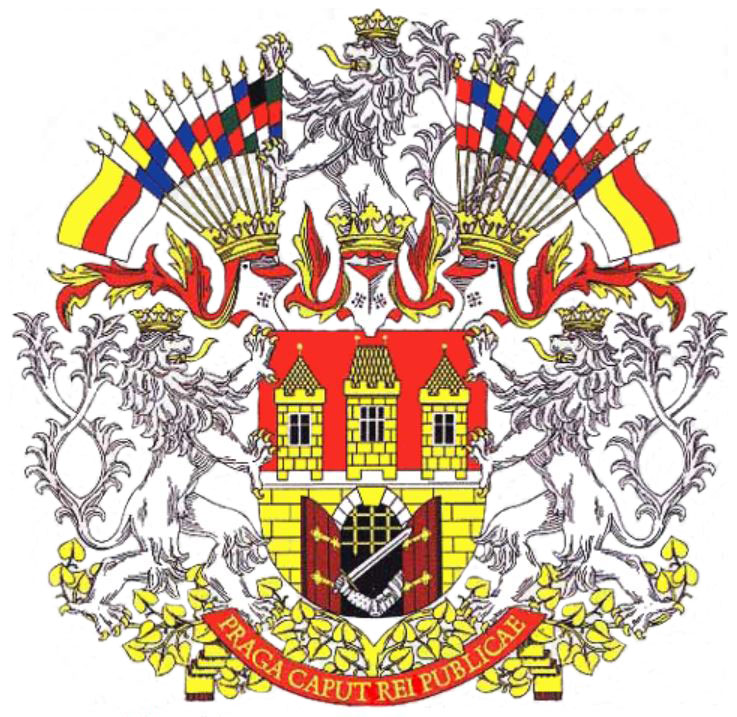
The Slovakian emblem is no longer present in the central Bohemian Lion.
The motto changes from “Prague, Mother of All Cities” to “Prague, Capital of the Republic. And if you go back up this post to the picture of the terracotta coloured part of the Old Town Hall you can see the Latin “Praga Caput Regni” which means Prague Capital of the Kingdom. So we’ve gone full circle.
Fun Fact – Any Czech Town or city can have it’s own coat of arms. They simply apply to the Sub-Committee for Heraldry and Vexillology. An historic investigation of that municipality is completed and a coat of arms is issued.
